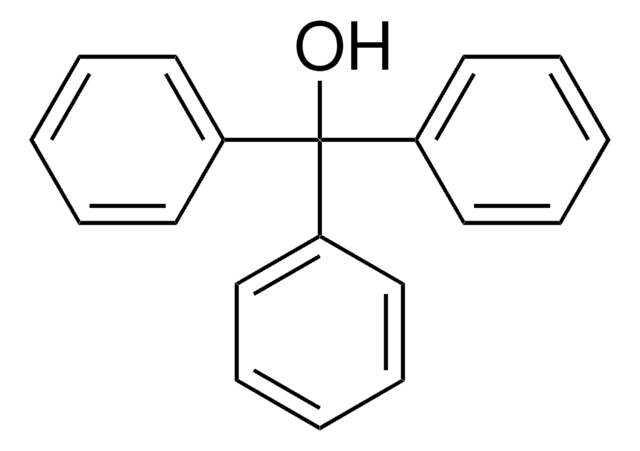Wichtige Dokumente
650609
Methanol
≥99.9%, HPLC Plus, suitable for HPLC, poly-coated bottles
Synonym(e):
Methylalkohol
About This Item
97.68 mmHg ( 20 °C)
Empfohlene Produkte
Produktbezeichnung
Methanol, HPLC Plus, ≥99.9%, poly-coated bottles
Qualität
HPLC Plus
Qualitätsniveau
Dampfdichte
1.11 (vs air)
Dampfdruck
410 mmHg ( 50 °C)
97.68 mmHg ( 20 °C)
Assay
≥99.9%
Form
liquid
Selbstzündungstemp.
725 °F
Expl.-Gr.
36 %
Methode(n)
HPLC: suitable
Verunreinigungen
≤0.0002 meq/g Titr. base
≤0.0003 meq/g Titr. acid
≤0.001% Carbonyl Compounds
≤1.0 ppb Fluorescence (quinine) at 254 nm
≤1.0 ppb Fluorescence (quinine) at 365 nm
<0.05% water
Abdampfrückstand
≤0.0001%
Farbe
APHA: ≤10
Brechungsindex
n20/D 1.329 (lit.)
bp
64.7 °C (lit.)
mp (Schmelzpunkt)
−98 °C (lit.)
Löslichkeit
benzene: miscible(lit.)
ethanol: miscible(lit.)
water: miscible(lit.)
Dichte
0.791 g/mL at 25 °C (lit.)
0.791 g/mL at 25 °C
HPLC-Gradient
≤2 mAU at 230 nm
≤5 mAU at 254 nm
λ
H2O reference
UV-Absorption
λ: 205 nm Amax: 1.0
λ: 210 nm Amax: 0.80
λ: 220 nm Amax: 0.20
λ: 230 nm Amax: 0.10
λ: 250 nm Amax: 0.02
λ: 400 nm Amax: 0.005
Format
neat
SMILES String
CO
InChI
1S/CH4O/c1-2/h2H,1H3
InChIKey
OKKJLVBELUTLKV-UHFFFAOYSA-N
Suchen Sie nach ähnlichen Produkten? Aufrufen Leitfaden zum Produktvergleich
Allgemeine Beschreibung
Anwendung
- Colony forming unit-fibroblast assay of bone marrow mononuclear cells.
- As solvent for the preparation of extracts of hyphae of Aspergillus for the estimation of gliotoxin by reversed phase-HPLC.
- Immunofluorescence studies.
- To compose eluent for the ion-pair reverse-phase HPLC isolation of nucleotides and their decomposition products.
- As eluent in the HPLC estimation of malondialdehyde in plasma, which is an indicator of oxidative stress.
Angaben zur Herstellung
Signalwort
Danger
H-Sätze
Gefahreneinstufungen
Acute Tox. 3 Dermal - Acute Tox. 3 Inhalation - Acute Tox. 3 Oral - Flam. Liq. 2 - STOT SE 1
Zielorgane
Eyes,Central nervous system
Lagerklassenschlüssel
3 - Flammable liquids
WGK
WGK 2
Flammpunkt (°F)
49.5 °F - closed cup
Flammpunkt (°C)
9.7 °C - closed cup
Persönliche Schutzausrüstung
Eyeshields, Faceshields, Gloves
Hier finden Sie alle aktuellen Versionen:
Besitzen Sie dieses Produkt bereits?
In der Dokumentenbibliothek finden Sie die Dokumentation zu den Produkten, die Sie kürzlich erworben haben.
Kunden haben sich ebenfalls angesehen
Unser Team von Wissenschaftlern verfügt über Erfahrung in allen Forschungsbereichen einschließlich Life Science, Materialwissenschaften, chemischer Synthese, Chromatographie, Analytik und vielen mehr..
Setzen Sie sich mit dem technischen Dienst in Verbindung.







